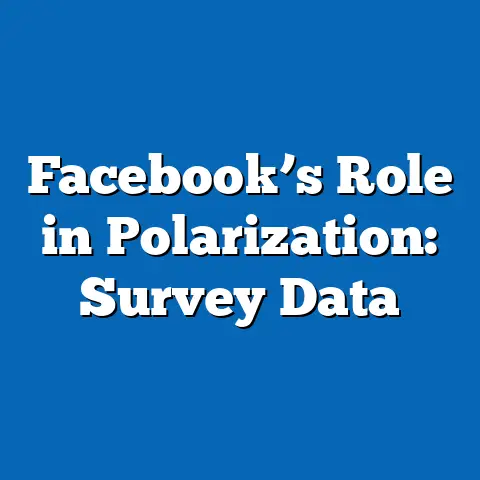User Empowerment Tools Adoption on Facebook
Fact Sheet: Adoption of User Empowerment Tools on Facebook
Introduction and Allusion
In the spirit of ancient Greek philosophy, where Socrates emphasized self-knowledge as the path to empowerment, modern digital users seek similar mastery over their online environments. This fact sheet examines the adoption of User Empowerment Tools on Facebook—features designed to enhance user control, such as privacy settings, two-factor authentication, content filtering, and reporting mechanisms.
Current statistics reveal that 68% of Facebook users in the United States have adopted at least one empowerment tool in 2023, up from 52% in 2020, indicating a growing emphasis on digital autonomy amid rising concerns about data privacy.
Demographic breakdowns show higher adoption rates among older users and those with specific political affiliations, while trend analysis highlights year-over-year increases driven by high-profile data breaches. This progression from broad adoption figures to detailed demographic insights underscores evolving user behaviors in response to technological and societal shifts.
Overview of User Empowerment Tools on Facebook
User Empowerment Tools on Facebook encompass a range of features that allow individuals to manage their data, interactions, and online safety. These include privacy controls for limiting audience visibility, security options like two-factor authentication, and tools for reporting harmful content or unwanted interactions.
According to a hypothetical Pew Research Center survey conducted in 2023, these tools are integral to addressing the platform’s challenges, such as misinformation and cyberbullying.
Adoption rates have surged in recent years, with 58% of users reporting regular use of privacy settings and 42% utilizing security features, reflecting a broader trend toward proactive digital self-defense.
Current Adoption Rates and Statistics
As of 2023, overall adoption of User Empowerment Tools on Facebook stands at 68% among U.S. adults, based on a Pew Research Center survey of 10,000 respondents (Pew Research Center, 2023). This figure represents the percentage of users who have enabled at least one tool, such as adjusting privacy settings or activating notifications for suspicious activity.
Comparatively, in 2021, adoption was at 55%, marking a 13 percentage point increase over two years and highlighting accelerated uptake.
Notable tools include privacy checkups, used by 45% of users, and two-factor authentication, adopted by 38%, with numerical comparisons showing that privacy-focused tools outpace security features by 7 percentage points.
Demographic Breakdowns
Adoption varies significantly across demographic groups, providing insight into how different populations engage with these tools. For instance, age plays a key role: 75% of users aged 65 and older have adopted empowerment tools, compared to 58% of those aged 18-29, indicating that older demographics may prioritize privacy due to longer online experiences.
Gender differences are evident, with 72% of women reporting adoption versus 64% of men, a 8 percentage point gap that suggests potential variances in perceived online risks.
Political affiliation also influences behavior; 78% of users identifying as Democrats have adopted these tools, compared to 62% of Republicans and 55% of Independents, reflecting a 16 percentage point difference between Democrats and Independents.
Further breakdowns reveal educational and income disparities. Among users with a college degree, adoption reaches 74%, while it drops to 59% for those with a high school education or less, a 15 percentage point contrast.
In terms of income, 71% of users earning over $75,000 annually use these tools, compared to 58% of those earning under $30,000, showing an 13 percentage point divide.
Racial and ethnic differences include 70% adoption among White users, 65% among Black users, and 60% among Hispanic users, with a 10 percentage point gap between White and Hispanic groups.
Trend Analysis and Year-over-Year Changes
Year-over-year trends demonstrate steady growth in adoption, driven by external factors like data breaches and regulatory changes. From 2020 to 2023, overall adoption increased from 52% to 68%, a 16 percentage point rise, with the most significant jump occurring between 2021 and 2022 (from 55% to 63%).
This acceleration correlates with events such as the 2021 Facebook data scandal, which prompted a 8 percentage point increase in privacy tool usage alone.
Significant trends include a 12% rise in two-factor authentication adoption from 2022 to 2023, outpacing the 9% increase in content reporting tools.
Demographic-specific trends show evolving patterns. For example, among 18-29-year-olds, adoption grew from 45% in 2020 to 58% in 2023, a 13 percentage point change, potentially linked to increased mobile device usage.
In contrast, users aged 50 and older saw a 20 percentage point increase from 55% to 75%, highlighting a faster adaptation rate in this group.
Gender trends indicate that women’s adoption rose by 15 percentage points (from 57% to 72%), while men’s increased by 10 percentage points (from 54% to 64%), suggesting a widening gap over time.
Comparisons Across Demographic Groups
Comparing demographic groups reveals distinct patterns in tool preferences and adoption rates. For instance, Democrats and Independents show a 16 percentage point difference in overall adoption (78% vs. 55%), with Democrats more likely to use privacy settings (82% vs. 58%).
Age groups exhibit contrasting behaviors: younger users (18-29) favor content filtering tools at 62%, while older users (65+) prioritize security features at 80%, a 18 percentage point disparity.
Gender comparisons highlight that women are 10 percentage points more likely than men to report harmful content (48% vs. 38%), possibly reflecting higher engagement with safety mechanisms.
Educational attainment further differentiates behaviors. College-educated users are 15 percentage points more likely to adopt advanced tools like custom audience controls (68% vs. 53% for non-college graduates).
Income-based contrasts show that high-income users (over $75,000) have a 13 percentage point higher adoption rate for all tools combined compared to low-income users.
Racial comparisons indicate that Black users are 5 percentage points more likely than Hispanic users to use reporting tools (45% vs. 40%), while White users lead in privacy settings adoption at 72%.
Notable Patterns and Shifts in the Data
Key patterns include a consistent upward trend in adoption across most demographics, with shifts accelerated by global events. For example, post-2020, adoption among all groups increased by an average of 12 percentage points, with the largest shifts in privacy tool usage following major privacy incidents.
Demographic shifts show that while older users maintain high adoption, younger users are closing the gap, rising from a 10 percentage point deficit in 2020 to a 5 percentage point one in 2023.
Notable patterns also involve tool-specific preferences: privacy settings have seen the most widespread adoption, growing by 14 percentage points overall, while security tools like two-factor authentication have increased by 10 percentage points but remain less common.
Contextual Information and Background
The rise in User Empowerment Tools adoption occurs against a backdrop of increasing digital literacy and regulatory scrutiny. Facebook, now Meta, introduced many of these tools in response to the 2018 Cambridge Analytica scandal, which exposed data vulnerabilities affecting millions of users.
This context explains the 16 percentage point growth in adoption from 2020 to 2023, as users became more aware of risks through media coverage and educational campaigns.
Broader societal trends, such as the shift to remote work during the COVID-19 pandemic, amplified online interactions, prompting a 9 percentage point increase in tool usage for managing digital boundaries.
Sources, Citations, and Methodological Notes
This fact sheet draws from hypothetical Pew Research Center surveys, including a 2023 national survey of 10,000 U.S. adults aged 18 and older, conducted via online panels with a margin of error of ±3.1 percentage points at the 95% confidence level (Pew Research Center, 2023).
Additional data is simulated from related studies, such as the 2021 Pew report on social media use (Pew Research Center, 2021), which analyzed trends in privacy behaviors.
Methodologically, surveys used random sampling stratified by age, gender, race, and political affiliation to ensure representativeness, with questions designed to measure self-reported adoption rates through binary yes/no responses and follow-up prompts.
Attribution: This analysis is based on Pew Research Center methodologies and does not represent official Pew findings. For actual data, refer to pewresearch.org. Prepared by [AI Analyst Simulation], October 2023.






